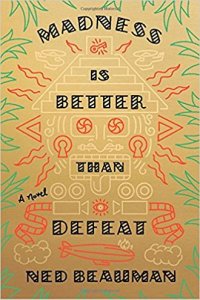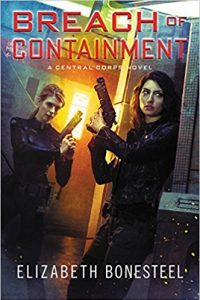Paul Di Filippo reviews Madness Is Better Than Defeat by Ned Beauman
Madness Is Better Than Defeat, by Ned Beauman (Knopf 978-0-385-35299-4, $27.95, 416pp, hardcover) February 2018
 When I reviewed Ned Beauman’s first two novels–Boxer, Beetle and The Teleportation Accident–I concluded by citing “his endless fecundity of invention and specificity. No setting is unburnished, no individual, even walk-ons, left undistinguished. Second, and more amazing, is his patterning ability — a skill so important to an author yet one of those writerly talents hard to quantify and rarely cited in reviews.” Coming to his third book, Glow, I concluded:
When I reviewed Ned Beauman’s first two novels–Boxer, Beetle and The Teleportation Accident–I concluded by citing “his endless fecundity of invention and specificity. No setting is unburnished, no individual, even walk-ons, left undistinguished. Second, and more amazing, is his patterning ability — a skill so important to an author yet one of those writerly talents hard to quantify and rarely cited in reviews.” Coming to his third book, Glow, I concluded:
This is not a book where flashy technique trumps humanism, humor, genuine speculation, or engagement with the real world. Beauman has plenty to say on a lot of Big Topics, as well as educing eternal human behaviors — it’s just that he delivers his pronouncements and observations in what amounts to one of those wooden sculptures — a ball, a box — whose three-dimensional jigsaw components must be slid this way and that, sometimes nonintuitively, to disassemble the unit.
Thus thrilled and enamored, news of his fourth novel was met in these quarters with high excitement. I am happy to report that all anticipations were honored, in spades. This book surpasses even its predecessors in gonzo inventions, vibrant, zesty, slaphappy prose, and some rather poignant observations on our improbable, doomed civilization.
We start out in the year 1959 with a bit of a frame tale. Our first-person teller is an ex-reporter, ex-CIA guy named Zonulet. In rambling, obscurantist fashion he lets us know that he had a mystical, weird-ass experience in a lost Mayan temple that completely upended his life and got him canned from the spooks. Now he is searching through a vast government warehouse (cue the closing scene of Raiders of the Lost Ark here) for proof of his sanity and truthfulness. (Partway through the novel, he will get a young female intern as a helper, Frieda: “twenty years old and so molten with youth under that prim gingham dress that she’s almost painful to look at, like an ingot just pulled from the furnace…”) And even later on, an old journalist comrade, Meredith Vansaska, will resurface to help. But meanwhile, Zonulet is going to recount everything that led up to his life-changing epiphany, even stuff he did not personally witness, but only reconstructed.
So we jump back to the year 1938 and encounter the two central men whose interests in this lost Honduran temple will make everything else happen. One fellow is Elias Coehorn Jr, scion of a super-wealthy magnate, Elias Coehorn Sr. The father has learned of this rare temple and fancies having it as a folly on his estate. He instructs his son to take a team down south, deconstruct the temple, and ship it back.
Our other player is one Jervis Whelt, an aspiring film director in Hollywood. Summoned to the mansion of the powerful and half-mad film producer and studio head Arnold Spindler, Whelt is given the assignment of filming–on location at the selfsame temple–the movie version of a book titled Hearts in Darkness. Eager and ecstatic, Whelt takes off with his crew of some seventy-nine actors and techies, including a cunning and self-serving reporter named Leland Trimble, who will soon become the snake in their Eden.
Meeting in the jungle, the two factions, with their irreconcilable goals, clash. A Mexican standoff ensues, as neither program seems able to gain the upper hand. So the rivals plant their butts stubbornly, hoping to outlast each other. The addition of a Nazi on the lam after WWII and revelations about the exact paternity of our two jungle “heads of state” complicate matters mightily.
Eight years pass. Yes, in highly unreal yet utterly believable fashion, these stubbornly daft emissaries of Western Civilization go all Swiss Family Robinson-cum-Lord of the Flies. Whelt learns how to make his own film stock from native ingredients, while hedonistic playboy Coehorn seeks to refine a passable Eggs Benedict and Bloody Marys from local sources. Then, at some point, one of Whelt’s people finds an entrance into the temple, and discovers the uncanny secret at its core. Now the rivalry heats up, abetted by the new presence of a third faction, the ultra-secret arm of the CIA known as Branch 9, who set up their own temple-centric operations in the area. This uneasy tripartite standoff exists until Zonulet shows up in 1956 and destabilizes everything, resulting in an epic armageddon for all.
Beauman has great fun with depicting an allegorical competition between the two camps, representing East Coast autocratic uptightness and West Coast moonbat permissiveness. But the story also digs deep into the personalities of the big, sturdily and cleverly wrought cast, and as in Conrad’s Heart of Darkness, an explicit allusionary touchstone, the defects of character of each individual are what propel the tragedies. Nor does the author neglect his speculative elements, offering us Borgesian confusions of cause and effect.
In the end, Beauman is most concerned with obsessiveness and cultish indoctrination, the echo-chamber brainwashing of paranoid communities.
Where the first generation had never been more than grudging halfway adapters, the second was a genuinely new tribe, with Colby Droulhiole as its founder. They spoke in American accents and they had all been taught a sort of eschatology in which they would one day return with their parents to Hollywood or New York. But they belonged to the rain forest and to the temple. And the geometry of the latter—its steps underfoot or its rise overhead, depending on where they grew up—was so primal to them that any talk of disassembly or reassembly struck them as abstract. almost paradoxical.
Yet if you talked to the older kids in the Kingdom Pictures camp, you would find they believed at least as devoutly as their parents that the movie must be made. Of course, they had never seen a movie, but they had all played make-believe and drawn pictures, and they knew that a grand analogue of these activities called Hearts in Darkness was the central imperative of human life. “Are we making the movie right now?” children would sometimes ask, trying to understand. ‘No, not yet!” their elders would reply. Not until everything was finally ready, and the actors and actresses could stand in front of the cameras to say their lines.
This theme could not be more topical, and the colorful allegorization of it drives home the insanity more deeply than a hundred essayistic arguments.
But of course, any preachiness of tone and effect is invisible in this brightly colored tapestry of craziness. If you were to blend Catherynne Valente’s Radiance (mad apocryphal filmmaking) and Howard Hendrix’s Spears of God (spies and alien theophanies), you might end up with a distillate half as potent as Beauman’s book. But such a hybrid would not share Beauman’s flair for language or his tragicomic genius that shows us that all life is a very constricted stage, and all of us only marooned players in a jungle of good and bad intentions.







